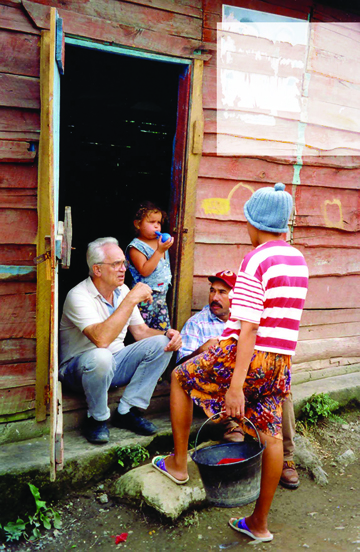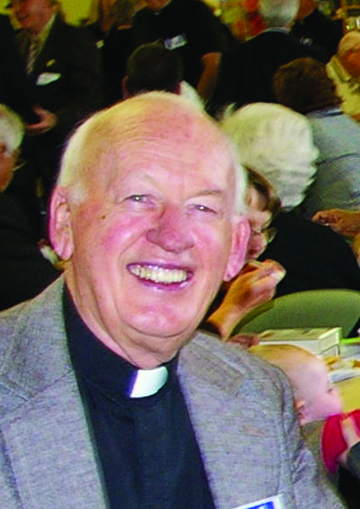Change
Looking back with profound gratitude at a transformative 52-year journey of priesthood, as student and then missionary
By Fr. Gerald Curry, S.F.M.
November/December 2008
Return to Table of Contents
Print Article
In every area of life change is a constant. Most people would agree that even the weather is changing, giving us concern for our planet and for our very survival. Change has been a constant in our personal and inner spiritual lives as well. I would like to share my journey and some of the highlights of change that have been part of my life.
Raised Catholic, I felt a quiet but constant pull toward the priesthood. After attending a Catholic university, I joined the Scarboro Foreign Mission Society for five years of preparation for missionary priesthood. I especially remember the Jesuit professors who taught us at St. Augustine’s Seminary in Toronto. Two of them were world-renowned in their field of scripture study; one was a professor of moral theology. They invited us to search and to question and awakened in us an enthusiasm for learning that sometimes led to unchartered paths. I can still remember the morning that one of our professors announced that Pope John XXIII had called the Church to an ecumenical council, Vatican II, in order to open the Church to the world. This confirmed that we students were not alone in our search for a deeper understanding of the Gospel and our responsibility to witness Christ in our world.
BEING MISSIONED TO JAPAN BEGAN A MAJOR CHANGE AS I WAS CONFRONTED BY A CULTURE AND PEOPLE VERY DIFFERENT FROM THE COMMUNITIES THAT HAD NURTURED ME.
Being missioned to Japan began a major change as I was confronted by a culture and people very different from the communities that had nurtured me. Less than two months after we arrived, my classmate John Trainor and I stood in line with thousands of Japanese pilgrims as we made our way up the hill of the local Shinto Shrine. It was New Years Day 1962 and as newly minted missionaries we wanted to experience the Japanese way of opening to God on this their most important festival of the year, a festival of thanksgiving and petition to their Shinto gods and goddesses.
 Scarboro missionary Fr. Lou Quinn, who died in October 2007 after more than 50 years of commitment to the poor in the Dominican Republic.
Scarboro missionary Fr. Lou Quinn, who died in October 2007 after more than 50 years of commitment to the poor in the Dominican Republic.
As time went on I would learn to respect the Shinto and Buddhist approach to God. Indeed I was simply returning the respect they gave to me as a person and as a Christian. In the months and years to follow, I would discover God’s presence in this culture and people. I came to understand that the witness of my Christian faith would help them in their journey and their search for God. I came to believe that the witness of the Christian community and its openness to the needs of the other, helped the Japanese in their search for meaning, helped them to be better Buddhists and Shintoists.
Return to Canada
The second chapter of my missionary journey began in 1975 when I returned to Canada to take on the task of editor of Scarboro Missions magazine. Growing up in Cape Breton in a family of steelworkers had instilled in me the ideal of the common good expressed then in the steelworkers union movement, in cooperatives and credit unions, and indeed in all aspects of communal striving for common good.
The witness of many of my fellow missionaries and my exposure to the reality of Latin America, coupled with the waste and insanity of the Cold War led me to collaborate in producing a magazine that would be a voice for those who struggle for their own human dignity, for those who struggle for justice and peace in our world.
Myself and many of my colleagues at Scarboro challenged the issues of the 70s with the teaching of Christ to love, to renounce war, to be inclusive. We challenged the Cold War, Apartheid, the New International Economic Order (the beginnings of globalization) because of the impoverishment and suffering they imposed upon a majority of peoples. I had seen an example of this new order in the early 70s in my hometown of Sydney; more than 500 people lost their jobs when their plant was closed and moved to Mexico where the cost of labour was cheap and there were no benefits for the workers or concern for their safety. The common good was set aside, the workers in Sydney lost their jobs as an era of greed reigned.
A new vision of Church
Vatican II had called the Church to a new vision of itself as the People of God. The Council said that “the joys and the hopes, the griefs and the anxieties of the men of this age, especially those who are poor or in any way afflicted, these are the joys and hopes, the griefs and anxieties of the followers of Christ.” In 1974, Scarboro invited the laity to join as missionaries. Eventually the teaching of Christ for justice and peace was acknowledged as a core teaching of the Gospel.
In 1975 I met Patrick Hughes, a former Paulist priest whose talent and expertise in communications enabled him to portray and to convey the connection of the Gospel to the issues of the day. Patrick enabled others through audiovisual presentations to see and understand the complicity of many (including us Christians) in the evils of the day. Patrick made explicit the connection between the Gospel and the world and helped to change me and so many others in our understanding of living our Christian faith in the world.
FOR 52 YEARS I HAVE BEEN PART OF SCARBORO’S JOURNEY…THE FAITH OF MY COLLEAGUES HAS STRENGTHENED MY FAITH. THEIR CONCERN FOR THOSE THEY SERVED STRENGTHENED MY CONCERN.
In the late 80s, I met Ched Myers, first through his writings and then finally in person. Ched’s books “Binding the strong man” and “Who will roll away the stone” emphasize the social and political dimensions of Christ’s words and deeds as told by Mark in the first Gospel. Ched’s ability to see and understand the actions of Christ in the world in which He lived helped me to experience an incarnated, human Christ who exposed evil in the culture and religion of His day. Ched continues to be a mentor for me, proclaiming a Christ who calls his disciples to “see and understand.”
In the early 90s I met Deo Kernahan, a teacher by profession, a family man, a native of Trinidad, and a follower of the Hindu faith. Deo’s faith was personal but never private, he reached out to the world. He joined his interfaith journey with ours at Scarboro, a journey that continues on as part of Scarboro’s outreach in Canada and around the world.
Last, but truly first, has been the gift to me of my Scarboro community. In the summer of 1955 I visited Scarboro’s Central House on Kingston Road in Toronto. I was greeted by then Superior General Fr. Tom McQuaid and a newly ordained priest, Fr. Tom O’Toole, who was soon to leave for Japan. (Little did I realize that six years later I would be joining Fr. O’Toole in Japan.) Both men impressed me with their friendliness. Their welcome helped me to decide that this was the community I wanted to be part of. Hospitality, I would learn, is an enduring trait of Scarboro.
For 52 years I have been part of Scarboro’s journey, first as student and then as missionary. The faith of my colleagues has strengthened my faith. Their concern for those they served strengthened my concern for those I served.
For my family, my community, my friends and colleagues, for the constant change that has led me to where I am today, I can only respond with profound gratitude.
Return to Table of Contents
Print Article
